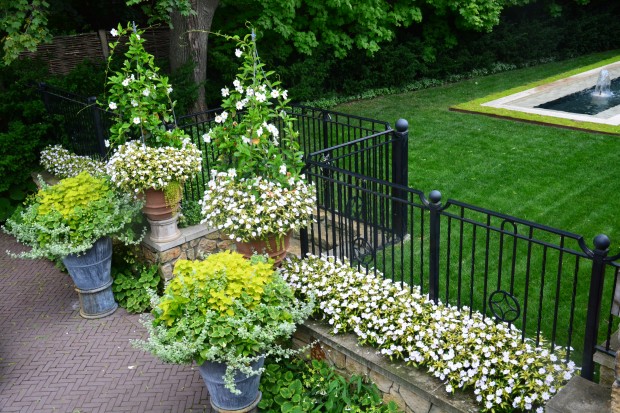 My summer driveway garden has only one flowering plant-a white sunpatiens with a variegated leaf. Lots of them. I am astonished at how well this plant has performed, given less than ideal sun, chilly temperatures, and relentless rain. The plants have grown at an astonishing rate, and shrug off troublesome weather. The Japanese beetles did not touch them-I like to think that is because they wouldn’t dare attack a plant this robust. The white mandevillea vine is not flowering profusely, but it is flowering enough to suit me. All of the other plants are various shades of green. Green plants in pots have one big visual advantage. They never look like they are missing something.
My summer driveway garden has only one flowering plant-a white sunpatiens with a variegated leaf. Lots of them. I am astonished at how well this plant has performed, given less than ideal sun, chilly temperatures, and relentless rain. The plants have grown at an astonishing rate, and shrug off troublesome weather. The Japanese beetles did not touch them-I like to think that is because they wouldn’t dare attack a plant this robust. The white mandevillea vine is not flowering profusely, but it is flowering enough to suit me. All of the other plants are various shades of green. Green plants in pots have one big visual advantage. They never look like they are missing something.
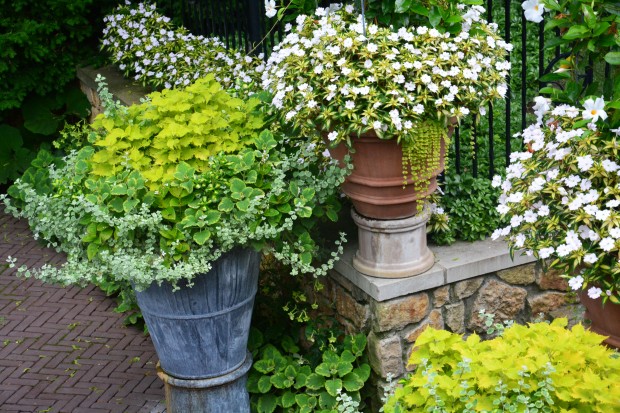 The flowering plants on my deck are making a strong comeback from the cold and torrential rains. A big pot of lilac New Guinea impatiens is budding-but is missing all of its flowers. Likewise the pots of geraniums. Both geraniums and New Guineas have beautiful foliage, but I do not grow them with that in mind. I grow them for the flowers-the color. They been missing flowers for several weeks now. The driveway garden looks perfectly happy.
The flowering plants on my deck are making a strong comeback from the cold and torrential rains. A big pot of lilac New Guinea impatiens is budding-but is missing all of its flowers. Likewise the pots of geraniums. Both geraniums and New Guineas have beautiful foliage, but I do not grow them with that in mind. I grow them for the flowers-the color. They been missing flowers for several weeks now. The driveway garden looks perfectly happy.
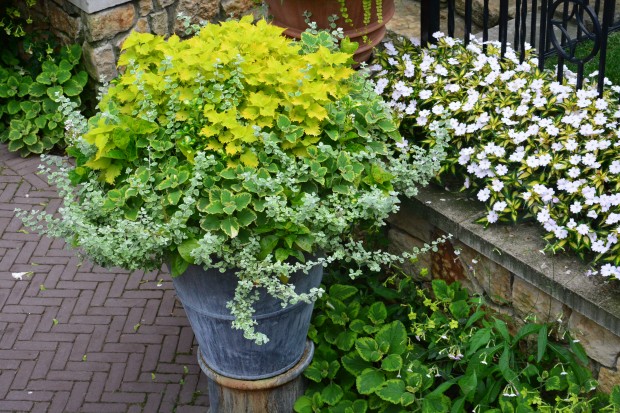 These green plants took the hostile weather in stride, and have grown steadily. No rotting flower heads to contend with. Every one of the plants in these pots is a different shade of green, a different texture, and a different shape. I have not touched these pots except to water when necessary. The pots are large, and the soil is completely shaded by plants. I have watered twice in the past 2 weeks. Now that our temperatures are climbing into the 80’s, I will water accordingly. I suppose I could pinch the plants in these pots, but I am more interested to see how they will sort things out for themselves.
These green plants took the hostile weather in stride, and have grown steadily. No rotting flower heads to contend with. Every one of the plants in these pots is a different shade of green, a different texture, and a different shape. I have not touched these pots except to water when necessary. The pots are large, and the soil is completely shaded by plants. I have watered twice in the past 2 weeks. Now that our temperatures are climbing into the 80’s, I will water accordingly. I suppose I could pinch the plants in these pots, but I am more interested to see how they will sort things out for themselves.
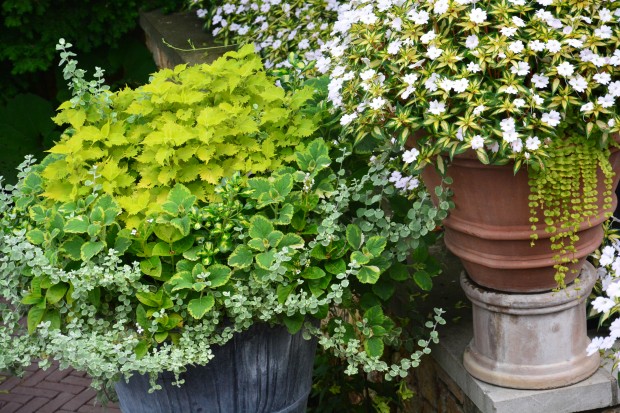 Plants in annual contrainers should be planted with an eye to the eventual overall shape. The lower pots do not have a vertical growing centerpiece. This pot looks like a big salad-delicious enough to eat. Like all of the plants in my landscape, they have appreciated the cooler weather and ample rain. No pouting going on here.
Plants in annual contrainers should be planted with an eye to the eventual overall shape. The lower pots do not have a vertical growing centerpiece. This pot looks like a big salad-delicious enough to eat. Like all of the plants in my landscape, they have appreciated the cooler weather and ample rain. No pouting going on here.
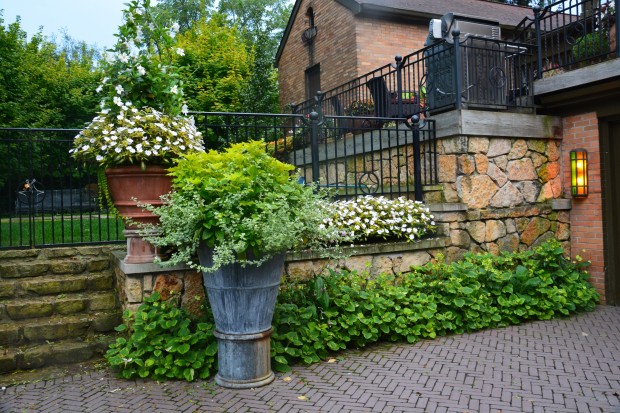 This planting looks good with my butterburrs, the Princeton Gold maples in the background, and hosta behind me. The choice of plants for these containers has a lot to do with the plants in the vicinity. The drive court is large; the plant palette is limited to the moss between the bricks. These green plants recall and reinforce the overall landscape.
This planting looks good with my butterburrs, the Princeton Gold maples in the background, and hosta behind me. The choice of plants for these containers has a lot to do with the plants in the vicinity. The drive court is large; the plant palette is limited to the moss between the bricks. These green plants recall and reinforce the overall landscape.
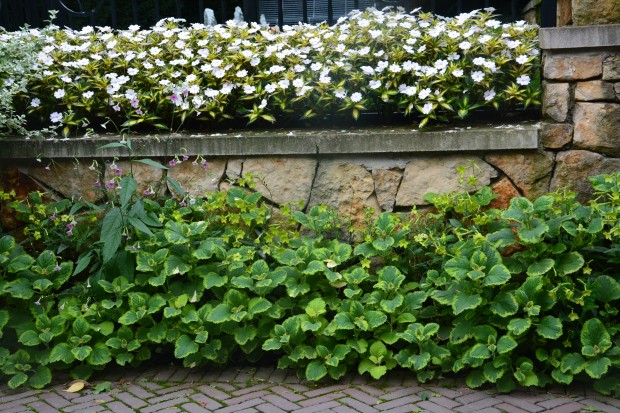 An errant nicotiana mutabilis in a sea of green and gold plectranthus, and some nicotiana alata lime has a few pink flowers. Should it grow strongly over the fall, I doubt I will mind the interruption. A plant that would breach the strongly horizontal lines would be welcome.
An errant nicotiana mutabilis in a sea of green and gold plectranthus, and some nicotiana alata lime has a few pink flowers. Should it grow strongly over the fall, I doubt I will mind the interruption. A plant that would breach the strongly horizontal lines would be welcome.
 In a spot where five different hard materials come together-the wall stone, the limestone cap, the wood, the wall brick, and the driveway brick – the repetition of a limited number of plants is a softening gesture.
In a spot where five different hard materials come together-the wall stone, the limestone cap, the wood, the wall brick, and the driveway brick – the repetition of a limited number of plants is a softening gesture.
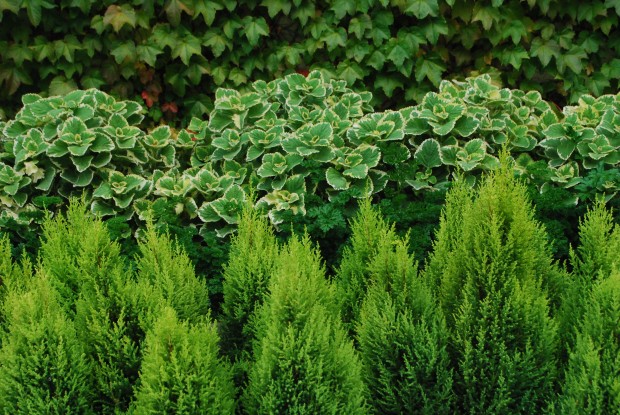 Greens done well are hard to beat. The three plants in the above picture, though formally arranged in rows, contrast in shape, surface, form, mass and texture. Variation on a green color scheme provide plenty of visual interest.
Greens done well are hard to beat. The three plants in the above picture, though formally arranged in rows, contrast in shape, surface, form, mass and texture. Variation on a green color scheme provide plenty of visual interest.
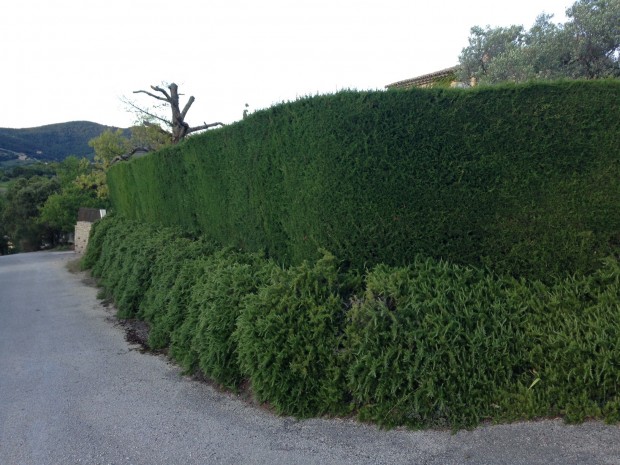 A friend traveling in France a month ago sent me this picture of a formally pruned juniper hedge, under planted with a skirt of trailing rosemary. The pairing of two needle-foliaged plants of very similar color and form is taken to another dimension all together by a decision to selectively prune. There is a gardener with a point of view at work here. The elements of good design may begin with the shapes of spaces, and architectural elements, but a green vocabulary never hurts.
A friend traveling in France a month ago sent me this picture of a formally pruned juniper hedge, under planted with a skirt of trailing rosemary. The pairing of two needle-foliaged plants of very similar color and form is taken to another dimension all together by a decision to selectively prune. There is a gardener with a point of view at work here. The elements of good design may begin with the shapes of spaces, and architectural elements, but a green vocabulary never hurts.
In the second last photo, could you please tell me what the variegated plant is in the middle row? Thanks!
Lisa, white variegated plectranthus, which is a relative of coleus. Best, Deborah
I love them! I like shades of green and simple subtle design. The white with the greens gives a nice cool feeling perfect for summer : ) I am inspired…have two iron urns that I am about to plant.
So pretty!
Kermit has always maintained “it’s not easy being green”, but with your verdant photos, you make it easier and easier to pare our palettes each and every day! Your driveway is beautiful and how many of us can say that??? Thanks for teaching us so well.
Stunning and peaceful joy for the eyes!
In your 5th and 6th picture what is the plant growing along the edge of the driveway?Thank you.
Deb, it is green and gold plectranthus
Hi Deborah,
I love your posts as you have an excellent eye for design. My backyard garden which I started last fall is all made up of only white flowering plants and different shades of green foliage plants.
As my front garden has many trees and plants of different colours, I find the change very relaxing and quite beautiful in the evening. I will forward you a photo of my back garden through your email. I live in downtown Toronto and love that you live in Detroit which I believe shares a similar climate. Thanks for the great website!
Green is my favorite color!
I love the all green hedge ! Hope you are well and busy.
White and green is also my favorite palette. It looks very crisp and cool in the summer, and it never bores me. I don’t mind the lack of other color at all … In fact, I abhor the use of excessive color – a garden shouldn’t look like a tray of M&Ms! Just my taste 🙂
“A green vocabulary never hurts.” Thank you for those words of garden wisdom.
Hello, do you have more than one variety of Butterbur ? It seems like the ones by your driveway (that I remember from previous garden tours) are much larger – almost like they were grown in a jungle. Yet these ones by your stairs appear smaller ?
Julie
Dear Julie, the butterburrs are not pictured. What is on either side of the stairs is green and gold plectranthus-an annual foliage plant related to coleus. Best, Deborah